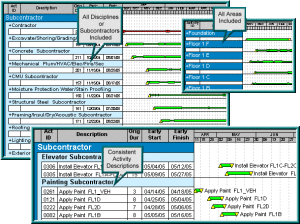When your contractor brings the Look Ahead schedule to an Owner’s meeting, are you comfortable with the information shown?

Does the pdf document include the columns you need to understand the status of the activities? And the Critical Path?
The Look Ahead schedule is a valuable tool for the contractor to communicate the planned work for the next few days, weeks, months….. Most schedule specifications have a requirement for one or two weeks back and four to six weeks ahead. Basically, the contractor filters the activities so only in progress and activities scheduled to start in the next four to six weeks are shown. This is very useful to the owner’s PM and site staff.
But what does the information tell us?
That depends on what columns are shown. Typically, the activity ID and Name are shown. The question is what are the other columns reporting? The Original Duration, OD is, of course, the planned duration for the activity. The Remaining Duration, RD is the workdays remaining for the activity. If the Actual Duration, AD column is shown, we can see the actual workdays progressed. You can ask your contractor to show the At Completion Duration. This will show the elapsed time between the actual start date and the scheduled finish date. The At Completion Duration may be much greater than the OD or the AD and RD because these are workday duration values. If this is the case, there may be a delay to the remaining work for the activity, a lack of production or some other reason work has been suspended for the activity which should be investigated and remedied.
Then there are the percent complete values. Which values are showing? The Duration % Complete is a function of RD divided by OD. This is really a duration measurement and does not tell us much about how much work is in place. Depending on the type of activity and percent complete type settings used for the project schedule, there could be a Physical % Complete, Activity % Complete, Schedule % Complete, Units % Complete, or Cost % Complete. I like to use physical for the percent complete type and enter the work in place progress in this column. But I could also use activity. Depending on the resource settings, the units % complete, schedule % complete and cost % complete can represent work in place based on units or cost. It can be very confusing to a PM looking at a pdf. Ask your contractor to show a column that represents the work in place progress, the duration progress, and the cost progress. They can explain each column so you know which is which.
Now the date columns. Some schedule specifications still require the early and late date columns are shown. I prefer to only show the Start and Finish date columns. If there is negative Total Float, TF for an activity, the early and late dates can be confusing. If I need to know what the late date would be, at a meeting, I can add the TF value in workdays to the Start date in my head and get very close at a meeting. Just remember, the dates for scheduled activities is only an output of the activity durations and logic for the schedule. Resist the temptation to state that an activity will start on a specific date. We don’t actually know what the future holds, but we can base an activity date on the predecessor activity durations and logic ties…..
Finally, we have the float column(s). I see schedule specifications that require both the Free Float, FF and Total Float, TF columns are shown. I prefer to only see the TF column. The FF only tells me how much float the activity has between the predecessor and the successor. The TF is more important to me as this tells me when a delay to an activity would impact the finish or interim milestone date.
Of course, none of this is of any use if the schedule is not a complete CPM schedule. Missing logic, excessive date constraints, a lack of realistic calendars, or improper update procedures can render a schedule invalid.
As a CPM Schedule Consultant, I find that a PM can review the percent complete for activity duration and work in place, the OD, RD and At Completion Duration, start and finish dates, and the TF values and have a pretty good understanding of the status of the current activities and near term work. If a PM digs into in-progress activities with negative TF or TF values near 0, they can manage what is driving the Critical Path now. If the activities are in progress and have At Completion Duration values greater than the OD, they can dig into the slippage now and begin mitigating delay early.
I’m sure many of you have comments or additional insight into this subject. Please share!
I’d love to hear what you think!
Please visit https://conschmanservices.com to learn more about Construction and Schedule Management Services, LLC
Please visit my LinkedIn account to learn more about me.
Please visit my “The Blue Book” ProView.
Paul Epperson CCM, PMP, PSP, PMI-SP
 My early construction schedule experience was gained while working on the owner’s side of the project. The issues I was concerned with were simple. Is the contractor on schedule? Will the contractor finish by contract completion? Have I delayed the contractor, and if so by how much?
My early construction schedule experience was gained while working on the owner’s side of the project. The issues I was concerned with were simple. Is the contractor on schedule? Will the contractor finish by contract completion? Have I delayed the contractor, and if so by how much?
 Now that you’ve
Now that you’ve